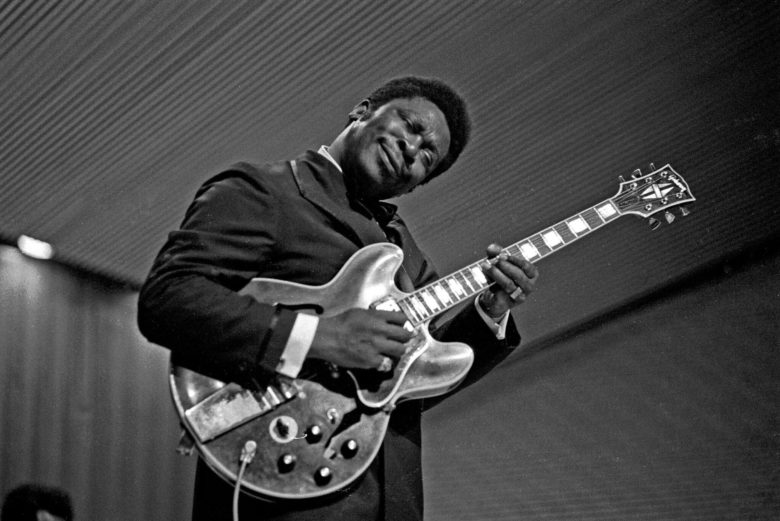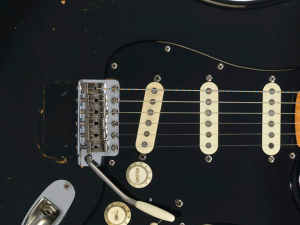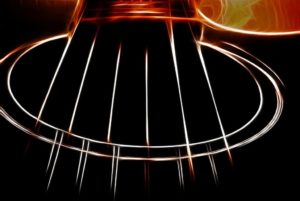Can you imagine the state of guitar music if we hadn’t been introduced to the Delta Blues Guitar style and Boogie from generations ago?
They’d be no Eric Clapton, Jimi Hendrix, Rory Gallagher, SRV, Angus Young, Peter Green, and many many others. We have a lot to thank them for.
So let’s look at the original musicians, their style, and the guitars that paved the way for the modern guitar player.
Our List Of Influential Musicians:
- Son House
- Robert Johnson
- Lightnin Hopkins
- Sister Rosetta Tharpe
- T-Bone Walker
- Muddy Waters
- Albert King
- B.B. King
- Chuck Berry
- Howlin Wolf
- John Lee Hooker
1. SON HOUSE: National 1930s Duolian
Edward James “Son” House Jr. (March 21, 1902– October 19, 1988)
Son was known for his emotional style of vocals and Delta Slide Guitar Blues.
Son’s unique style was down to his rhythmic punch, passionate vocals and emotional depth.
With a mix of string popping and trademark bottleneck slide, Son was in a league of his own and inspired generations of guitarists worldwide to recreate his style.
He favored various open tunings like G,D and D minor but also used standard.
Son was split between playing guitar for the righteous path of religion (as he was a preacher), but then becoming conflicted to play the ‘devil’s music’ The Blues! Son would often entertain the plantation workers with his armoury of songs.
After quitting music altogether in the early 40s, Son was found by blues enthusiasts in Rochester New York in 1964. He was completely unaware of the 1960s blues revival and huge worldwide admiration for his early recordings.
After revitalizing his career Son House continued to tour and do what he was best at. This success lasted until 1974 where he retired again to ill health.
Son House died in Detroit, Michigan in 1988.
Guitars:
There are plenty of photographs around of Son House holding a National 1930s Duolian, Triolian, or the Model ‘O’. He has been known to also play Stella early in the 1930’s recording sessions. Son also favored an early 20s Gibson L-1.
2. Robert Johnson: Kalamazoo KG-14
Robert Leroy Johnson (May 8, 1911 – August 16, 1938)
“robert-johnson” by raymaclean is licensed under CC BY 2.0
Robert Johnson really hit the good times during the 1936-37 period with his trademark combination of singing, guitar skill and amazing songwriting talents. He was the first guitarist in history to incorporate boogie woogie from piano to his finger picking slide techniques.
Johnson took that raw, rhythmic resemblance of the famous Delta Blues guitar sound. Mixed it up, absorbing all the influences that came before him. He created a perfect blend of innovative Country Blues.
He is very much one of the masters of the Delta Blues. Definitely one of the most influential musicians of his time. Jimmy Page was said to be a huge fan of Johnson.
Apparently Robert Johnson learnt to play guitar in a graveyard at night, perching on tombstones. I suppose that’s one way to get away from hustle and bustle and learn your chords.
Guitars:
Robert Johnson was famous for using a small number of guitars.
The 1928 Gibson Kalamazoo KG-14 being one of which he looked to favor. It had 14 frets to the body, five dot markers, a single layer of binding inside the soundhole, and a black ebony nut.
Other notable guitars Johson used were the Gibson L1 and possibly a Harmony Stella at some point.
3. Lightnin Hopkins: Guild Starfire IV
Samuel John “Lightnin'” Hopkins (March 15, 1912 – January 30, 1982)
“Lightnin’ Hopkins in Berkley” by Nesster is licensed under CC BY-SA 2.0
Lightnin Hopkins was a country blues singer, songwriter, and guitarist who began recording in 1946. He also occasionally played piano.
Hopkins’s style was to play unaccompanied with his own brand of fingerpicking, but with the help of a thumb pick. His superb technique and clever mid-tempo swinging blues in 12/8 were his unique characteristics.
Strongly influenced by Blind Lemon Jefferson, Hopkins would learn guitar at a very early age.
Hopkins would eventually end up playing with Jefferson at church gatherings.
After a long career, mostly unaccompanied Lightin Hopkins could impressively switch between musical genres and acoustic or electric guitars. His vocal was a ‘talkin blues’ style, like the great John Lee Hooker. His ability to freewheel and play completely improvisational would confuse and inspire session musicians around him
To this day components of his style are clearly found in Jimi Hendrix, Eric Clapton, Jimmy Page, and SRV.
Guitars:
Hopkins guitar on the cover of ‘The Texas Bluesman’ looks to be a Guild Starfire IV. He was also known to favor a Kay K-24 Jumbo, Gibson J-45s & J-50, also a Washburn.
4. Sister Rosetta Tharpe: 1929 Gibson L-5
Sister Rosetta Tharpe (March 20, 1915 – October 9, 1973)
“reitzlp1317_001” by Jazz Archive at Duke University is licensed under CC BY-NC-SA 2.0
Sister Rosetta was a prominent force in the 30s and 40s. A superb mix of spiritual lyrics from gospel music, later being referred to as the ‘original soul sister and the ‘godmother of soul.
She was the first to be recognized as a star from a gospel background and certainly the first to be recognized by the rhythm and blues and rock n roll audiences. A child prodigy, she would be performing at her local church by 6 years old! Here she developed her style cut from rural and urban elements.
Her amazing style and unique ability were picked up later by none other than Little Richard, Johnny Cash, Carl Perkins, Chuck Berry, Elvis Presley, and Jerry Lee Lewis. That’s not a bad list!!
Unfortunately, Rosetta doesn’t get the accolades she deserves this is probably due to her devotion to religious material. Later in life, she was perceived as the single most distinguished gospel artist of America.
Guitars:
It’s difficult to find anything other than the guitar Rosetta used, other than the beautiful 1929 National Triolian, Gibson L-5.
5. T Bone Walker: Gibson ES-5
Aaron Thibeaux “T-Bone” Walker (May 28, 1910 – March 16, 1975)
“T-Bone walker – T-Bone Blues” by comunicom.es is licensed under CC BY-SA 2.0
T-Bone Walker was a pioneer of the electric blues. He became the first musician to play the guitar as a solo instrument, a centerpiece of his dazzling live shows.
He was one of the original guitarists to give the world ‘jump blues’ and the ‘electric blues sound’. Walker was a classy performer and a silky singer.
His phrasing and melody set him aside from anybody else at the time. Walker would use attacking runs with powerful rhythmic fall back turning his guitar sound which revolutionized the instrument for years to come.
BB King cited hearing Walker’s Stormy Monday’ and drove him into buying an electric guitar. Jimi Hendrix played the guitar with his teeth, which was also a trait of T Bone Walker. Chuck Berry later said Walker was a huge influence on him.
T-Bone Walker is altogether one of the most important musicians to emerge from the latter part of the 29th century.
The ‘Jump Blues’
Guitars:
T Bone Walker played most of his career with the truly breathtaking flame-top Gibson ES-5 Electric Guitar. He also was said to have played a Gibson ES-250 and once borrowed Chuck Berry’s famous ES-335 for a live show.
6. Muddy Waters: Guild S-200 Thunderbird
McKinley Morganfield (April 4, 1913 – April 30, 1983)
“Muddy Waters at Newport 1960” by Nesster is licensed under CC BY-SA 2.0
Muddy Waters style of guitar was described as ‘raining down Delta beatitude’. He was a very important part of the post-war blues era. He was commonly known as the ‘father of modern Chicago blues’.
By the age of 13 Waters would play harmonica at gatherings. At 17 he’d saved enough money to buy his first guitar.
He was completely self-taught and would copy the likes of Robert Johnson and Son House. He traveled around Clarksdale playing as a kid playing with anyone and everyone he could find.
His first real electric band was with two exceptional musicians in harp player Little Walter Jacobs and guitarist Jimmy Rogers.
Muddy’s excellent timing, phrasing, and dynamic command of pitch, his spectrum of vocal effects, from falsetto to pure grit put him in a league of his own.
In 1958, he gained notoriety after he’d traveled to England, laying the foundations of the resurgence of interest in the blues there.
A very important figure in the story of blues music overseas and a major influence on the popularity of the delta blues guitar.
Guitars:
In 1968 Muddy was seen playing a Guild S-200 Thunderbird Electric Guitar at the Copenhagen Jazz Festival. He also had a Harmony Monterey, Stella Acoustics and a Fender Telecaster in his arsenal.
7. Albert King: Gibson 1968 Flying V
Albert Nelson (April 25, 1923 – December 21, 1992)
“Albert King – 1969 R-169” by Winston J.Vargas is licensed under CC BY-NC 2.0
The only lefty on the list. Back in those days, it wasn’t easy finding left-handed guitars. Albert King started out life playing a ‘diddley bow’ he’d built, then moved onto a cigar box guitar.
As he grew older and he learned to play the guitar flipped over (upside down). The left-handed Albert King was renowned for his deep and dramatic sound. This was later duplicated by both blues and rock guitarists.
Albert King was responsible for introducing his Memphis style into the blues. Some feat considering he appealed to both black and white audiences.
His laid-back vocal style mixed up with his intense string bending technique would go far and wide across the globe influencing such later greats as Eric Clapton and Jimi Hendrix.
King was once nicknamed “The Velvet Bulldozer” because of his smooth singing and large size.
Guitars:
You’ll probably recall Albert King is the man behind the Flying V’s. He had a few but the Cherry Red Gibson 1968 Flying V seems to be his most well-known. He also played a Bolin pink (Lucy) and a natural color.
8. B.B King: Gibson L30
Riley B. King (September 16, 1925 – May 14, 2015)
“BB King” by Daniele Dalledonne is licensed under CC BY-SA 2.0
B.B King is undoubtedly one of the most ‘important’ guitarists of all time. With his characteristic fluid string bending, beautiful glistening vibrato, and staccato picking. He has influenced many players and still, his style is prevalent in today’s music.
One of the hardest working musicians of his time. King would appear on stage more than 200 times a year, even into his 70s! He managed to outlive a lot of his friends and fellow musicians who passed away much earlier.
In 1947 he hitchhiked to Memphis, Tennessee in an attempt to chase his childhood dreams. Let’s all be thankful he made that trip.
After one of his shows in Arkansas, two men got into a brawl knocking over a gas stove. This then set the dance hall in a gulf of flames. B.B then realized he’d left his guitar inside and ran inside. The two men were still fighting over a woman called ‘Lucille’! B.B King then named his guitar after that woman. Reminding himself, never to fight over a woman.
There’s a reason he was nicknamed ‘The King Of The Blues’.
Guitars:
BB King played variants of the Gibson ES-355. He had his own Autographed Gibson BB King L-30 with added electronics. The original of these models was the actual ‘Lucille’. King was also known to play a red Stella and a J-45.
9. Chuck Berry: Gibson ES-335
Charles Edward Anderson Berry (October 18, 1926 – March 18, 2017)
“Chuck Berry” by Missouri Historical Society is licensed under CC BY-NC-ND 2.0
Chuck Berry single-handedly developed the rhythm and blues. He was heavily influenced by the riffs and showmanship of T Bone Walker. He had such a huge catalog of great catchy songs. By the end of the 1950s, Chuck Berry was a worthwhile superstar.
His showmanship and memorable guitar solos have put Berry right up the top of the most influential players of all time. You’ve seen Angus Young’s Strutt right? That’s from Chuck Berry (and possibly T Bone Walker before that)
Berry was taking an already popular rhythm and blues style and re-inventing it. This in turn would change the face of Rock n Roll forever. He invented the sound, the format, and the style for many guitarists ever since.
The guitar ‘solo’ would never be the same. Berry took that to a whole new level.
Guitars:
Chuck Berry’s memorable guitar was a Cherry Red Gibson ES335. In some footage, it seems he used chrome dogear P90s pickups, rather than the standard humbucker.
Other guitars to be added to his collection were: 1956 Gibson ES-350TN, Gibson Flying V Electric Guitar,
Gibson ES-350T, Gretsch 6130 Roundup Electric Guitar, Kay Thin Twin K-161, and a Gibson Super 400.

10. Howlin’ Wolf: Fender Coronado II
Chester Arthur Burnett, (June 10, 1910 – January 10, 1976)
“Howlin’ Wolf – Howling in the Moonlight” by comunicom.es is licensed under CC BY-SA 2.0
Although Howlin Wolf is not considered a legendary guitarist, he’s certainly worth his weight in gold when it comes to influencing the direction of the Chicago Blues sound.
With a gigantic booming voice and a very imposing physical presence, Wolf is the cornerstone of the urban blues from Chicago. Wolf was clever with the way he landed his accents around and on the beat. This skill was learned through thousands of hours of playing. This would free up rhythmic space for the other musicians to use wisely. This skill was unique to Howlin Wolf. Even though Hubery Sumlin and Wolf didn’t get along, they have a beautiful understanding when it comes to songwriting.
He later joined forces with guitarist Hubert Sumlin playing great Willie Dixon songs. This was a combination that defined the Chicago Blues sound. SOngs like Moanin’ At Midnight had a massive influence on the course of Blues music.
A Lot of artists at the time tried imitating his style but nobody had the trademark power when it came to his vocals. Thoughtful lyrics and earthy stage presence made Wolf like no other.
Howlin Wolf learned his trade on the cutthroat Chicago blues scene during the 50s. That was no easy feat considering the amount of raw talent about in those days
Guitars:
Many photos over the years show the following guitars: Fender Coronado II Semi-Hollowbody Electric Guitar, Fender Stratocaster Electric Guitar, Kay Thin Twin K-161 Kay Archtop, Guild G-212 12-string and a Harmony Sovereign flat-top. Some real nice guitars in there.
11. John Lee Hooker: Epiphone Zephyr
John Lee Hooker (August 22 1917 – June 21, 2001)
“Boogie On, John Lee Hooker (1917-2001)” by Mikey G Ottawa is licensed under CC BY-NC-ND 2.0
‘The King of Boogie’ created his own style from the Delta Blues. He integrated unique elements from ‘talking blues’. A style which is distinguished by ‘rhythmic speech’. The melody is in a free form, yet the rhythm stays strictly in line.
JLH developed the boogie style into his own driving tempo, detached from the 1930s/40s piano-based boogie. Taking the Delta Blues guitar sound from the acoustics of old into a more electric guitar-based swagger.
Hookers’ guitar and vocal style was uniquely deep and headed straight for your soul. Stomping beats and countless great songs make John Lee Hooker an absolute legend.
His characteristic raw, riveting Mississippi blues required a lot of a listener. With much emotion and incomparable creative spark, John Lee Hooker Stands alone in his work. Imitated still to this day, but in no way equaled.
He played and recorded on both acoustic and electric guitar in an open A tuning. Sometimes using a capo in that tuning to extend the keys.
Guitars:
Hooker was known to dabble with a number of Epiphone Sheratons, most notably a rare Epiphone Zephyr, a Kay Jumbo, a Goya acoustic, and a cherry red Gibson ES 330.
More AuthorityGuitar, Guitar Based Articles For You:








